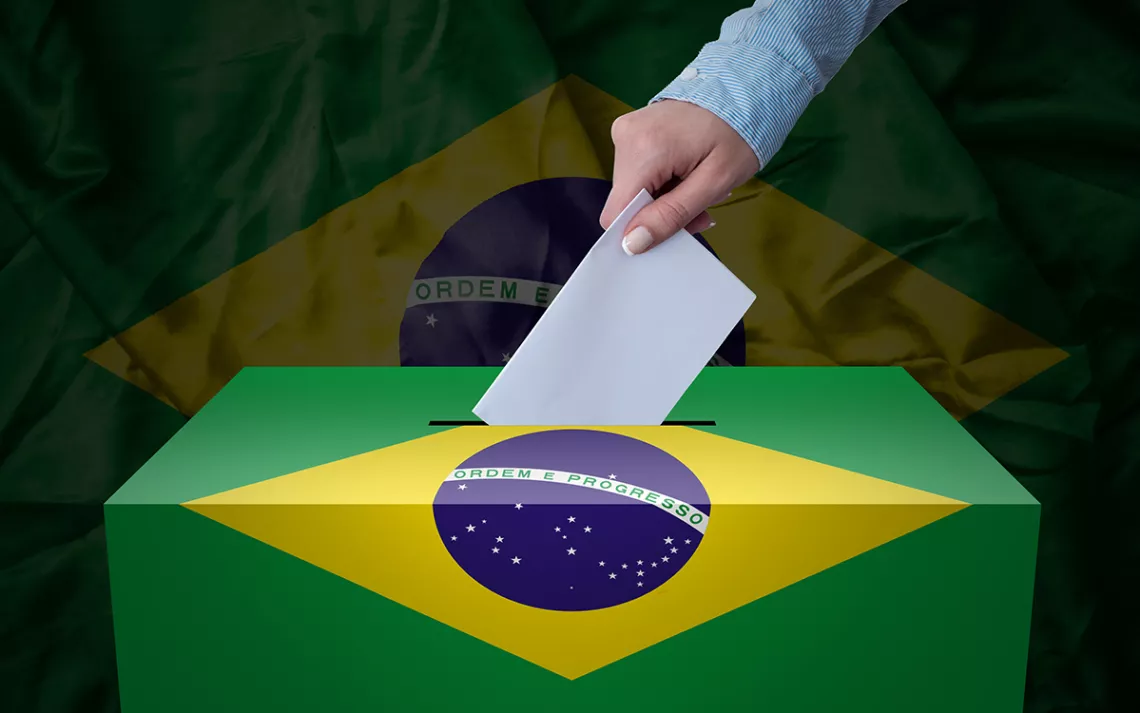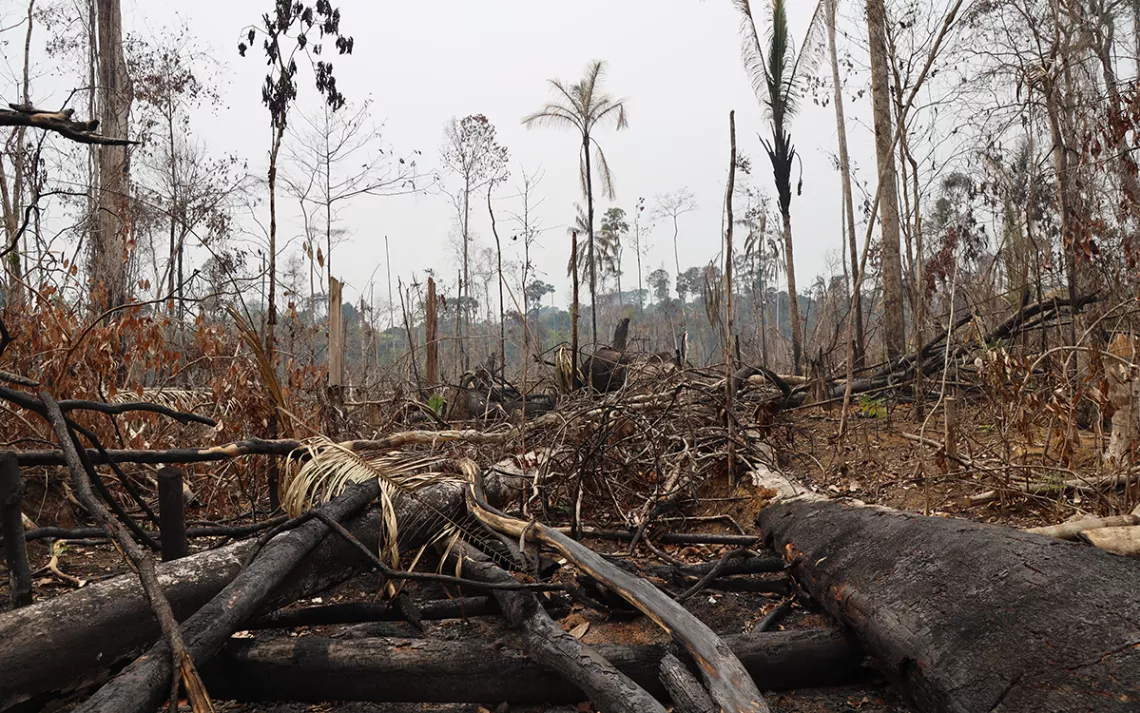The Most Important Environment-Related Election You’re Likely Not Following
In Brazil, a heated presidential contest could decide the fate of the Amazon Rainforest

Photo by iStock/Martinns
To get to Karipuna Territory in Brazil's Amazonian state of Rondonia, I first had to pass through miles of soy fields and cattle farms. Lands that just a few decades ago thrived as intact jungle forest are, today, a terrain of caked brown earth that, in the dry season, is reminiscent of a desert.
Once I reached the forest, it was like entering an entirely different world. Lush green trees hung overhead. The vegetation was so thick that it pushed up around the white pickup truck. But then the landscape opened up again. Broken trees lined the sides of the dirt road. They were slashed and burned and lay lopsided, like charred logs in a fireplace.
“They lit it just a couple of days ago,” my driver Eric Karipuna told me during a visit to the rainforest earlier this month.
We stepped out of the truck, and the smell of smoke filled the air. The forest was still smoldering.
“Each year, they cut and burn more,” he said.
The Indigenous Karipuna are under attack. For years, this community of some 61 people has struggled against invasions of their sovereign territory. Today, it’s much worse. Their territory is one of the top 10 most devastated Native lands in Brazil in recent years. About 11,750 acres of their land was destroyed between 2015 and 2021, according to government figures.
The Karipuna’s story is being repeated across the Amazon. Deforestation in the Amazon is at a 16-year high. About half of the current destruction is happening on Indigenous territories, conversation areas, and public lands. And a major culprit is far-right president Jair Bolsonaro, who since coming to power in 2019 has gutted the agencies and the polices that once protected the forests and the Native peoples living here. Bolsonaro’s administration has allowed illegal settlers to act with impunity, pushing onto Indigenous territories and conservation areas like never before.
"If Bolsonaro wins, I don’t believe the Amazon will make it more than 10 years,” says Federal University of Amazonas professor Gisele Costa. "Because he’s supported by the most aggressive sectors working against nature, against the Indigenous peoples.”
But that could soon change. On October 30, Brazil will hold a presidential runoff election that will decide whether Bolsonaro will stay in power, or if his challenger—former leftist president Luiz Inácio Lula da Silva—will return to the presidency. The two candidates have diametrically opposed visions for the Amazon. The election outcome will dictate the future of the world’s greatest forest, which is a vital carbon sink and home to a wealth of biodiversity.
"If Bolsonaro wins, I don’t believe the Amazon will make it more than 10 years,” says Federal University of Amazonas professor Gisele Costa. "Because he’s supported by the most aggressive sectors working against nature, against the Indigenous peoples, in both legal and illegal mining, which have opened up [like] cancerous tumors across Amazon region.”
Workers Party candidate Lula (as he is commonly known) defeated Bolsonaro by over 6 million votes in the first round of voting held on October 2. But Bolsonaro beat expectations, picking up 43.2 percent of the vote compared to Lula’s 48.4 percent. It turned the runoff campaign into a competitive horserace that has been plagued by fake news, disinformation, and an intense battle over social media. Lula leads Bolsonaro by between five and seven points in the latest polls.
“We’re going to win these elections so we can take care of the Amazon,” Lula said on October 16, during his first debate with Bolsonaro. “We are not going to allow invasions of Indigenous territories, illegal wild-cat mining, and much less allow people to plant corn or soy or anything else in areas where that should be grown.”
If Lula is elected and upholds that campaign promise, it would not be the first time that he has stepped up to defend the Amazon. Lula governed Brazil from 2003 through 2010. During his first years in power, deforestation was even greater than today. Then, Lula rolled out a series of landmark measures that cut deforestation in half within two years. Brazil hit its 2020 goal of reducing greenhouse gas emissions from deforestation ahead of schedule.

Devastated lands shown near Karipuna territory in Brazil. | Photo by Michael Fox
Karipuna leaders say they believe a Lula victory could be a turning point. The former president has even rekindled relations with his once estranged former environment minister, Marina Silva, with the hopes of returning to the issue of Amazon defense, if elected. But it will be a tough political battle. Experts say powerful criminal groups are more entrenched than ever in the region, and the pattern of deforestation has shifted.
“These criminal groups feel legitimized with the discourse of president [Bolsonaro] to support illegal miners on Indigenous land, to back cattle ranching on Indigenous land, and weakening the protections of Indigenous rights to their territory,” said Antenor Vaz, who worked for Brazil’s Indigenous agency, FUNAI, for years and coordinated the sector in charge of isolated Native peoples.
In the past, illegal loggers targeted the forests to extract valuable hardwood. Today, illegal land grabbers are simply slashing and burning the jungle in order to clear land to be sold as pastureland. Brazil is the largest exporter of meat in the world and the second largest producer of soy, after the United States—and cattle ranching, soy production, and mining are the primary drivers of Amazon deforestation.
The Yanomami territory, along the border with Venezuela, offers one example of the forces at play. As many as 20,000 illegal miners are now on Yanomami land. They’ve attacked communities, polluted rivers, and destroyed the forest. Last year, illegal wild-cat mining there grew by 46 percent, impacting over 8,000 acres of land, according to an April report from the Hutukara association, which represents more than 370 Yanomami and Yekauana communities there.
"This is a threat to the life of the forest, a threat to the lives of people who live in their villages,” said Dário Kopenawa, Hutukara vice president. “Mining kills. It murders people. It destroys the life of Mother Earth.”
On Yanomami land, land invaders move freely and with impunity. It’s the same for the Karipuna, as I saw it firsthand.
When I visited the Karipuna village for a few days this month, tribal members took me to see other areas of devastation on their lands. As we were driving, we turned a corner and up ahead were four motorcycles parked on the side of the dirt road, at the edge of the jungle.
“Invaders,” said Eric Karipuna.
We clicked a few cellphone pictures and quickly moved on.
Run-ins with land invaders on Indigenous territories in Brazil are frequently violent and sometimes deadly. Every few days, there’s a new story about another Indigenous person who’s been shot and killed on their land. According to a yearly report by the Indigenous Missionary Council, an ecumenical group that supports Indigenous communities in Brazil, 176 Indigenous people were killed last year in Brazil.
“What are they doing?” I asked.
“Probably surveying new areas to clear,” he said.
The Karipuna are under siege. There are few places for them to turn. And their plight will very likely continue to worsen if Brazil’s voters decide on October 30 to let Jair Bolsonaro remain in power.
 The Magazine of The Sierra Club
The Magazine of The Sierra Club



